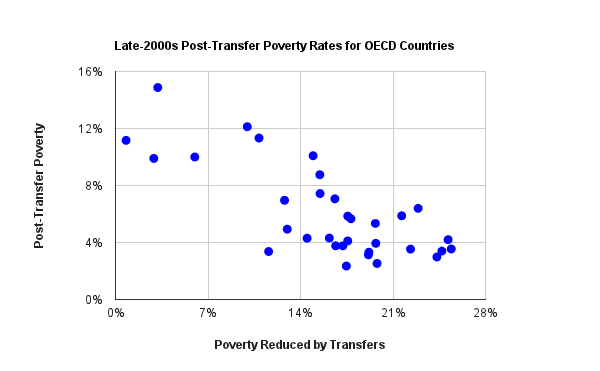Relative to other countries, poverty in the United States is quite high. High poverty levels are a problem both for baseline fairness reasons, but also for a host of welfare-related reasons. Poor people are subjected to higher levels of stress, risk, economic insecurity, and food insecurity. Poor people generally have worse health, decreased access to health care, and struggle more in school. Because living in poverty is very burdensome, reducing poverty levels should be a primary policy concern.
Given that some countries have low poverty while others have high poverty, a natural question presents itself: how exactly do countries with low poverty go about achieving low poverty? While we could have discussions about institutions, families, unions, wage floors, and any number of other things, one thing stands above the rest: tax and transfer programs.

Above is a plot I put together based on the late-2000s OECD data on poverty. The OECD poverty measurement I am using here is post-transfer incomes below 40% of the median income. The vertical axis represents the post-transfer poverty rate, and the horizontal axis represents the amount of poverty reduced by transfers. For example, Belgium has a pre-transfer poverty rate of around 29% and a post-transfer poverty rate of around 3.5%, meaning that the amount of poverty reduced by transfers in Belgium is around 25.5 percentage points. So on this graph, Belgium’s point is located around (25.5, 3.5).
As the plot shows, the countries with the lowest post-transfer poverty rates generally have the highest amount of poverty reduced by transfers. That is, the countries achieve low poverty by raising money through taxation and then transferring that money to poor people.
The United States has a post-transfer poverty rate of 11.3%, which ranks 32nd out of the 34 countries presented in the plot. Tax and transfer programs in the United States reduce poverty by 10.9%, which ranks the country 28th in the amount of poverty reduced by transfers. All the teeth-gnashing that goes on about family structures, education gaps, cultures of poverty, and everything else is small potatoes. If we want to reduce poverty in the United States, the countries with the lowest poverty have already shown how: give money to the poor, ideally taken from the rich.